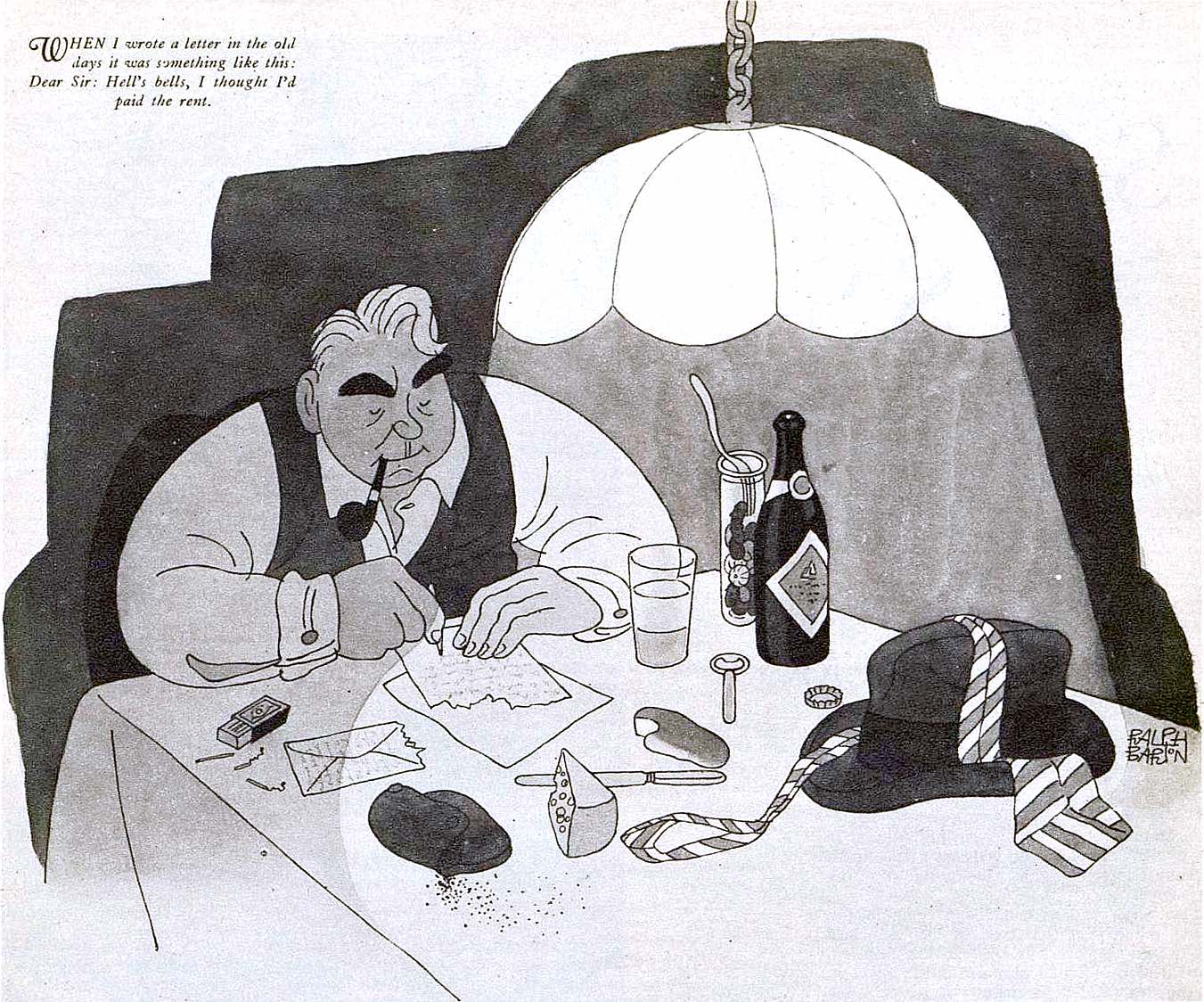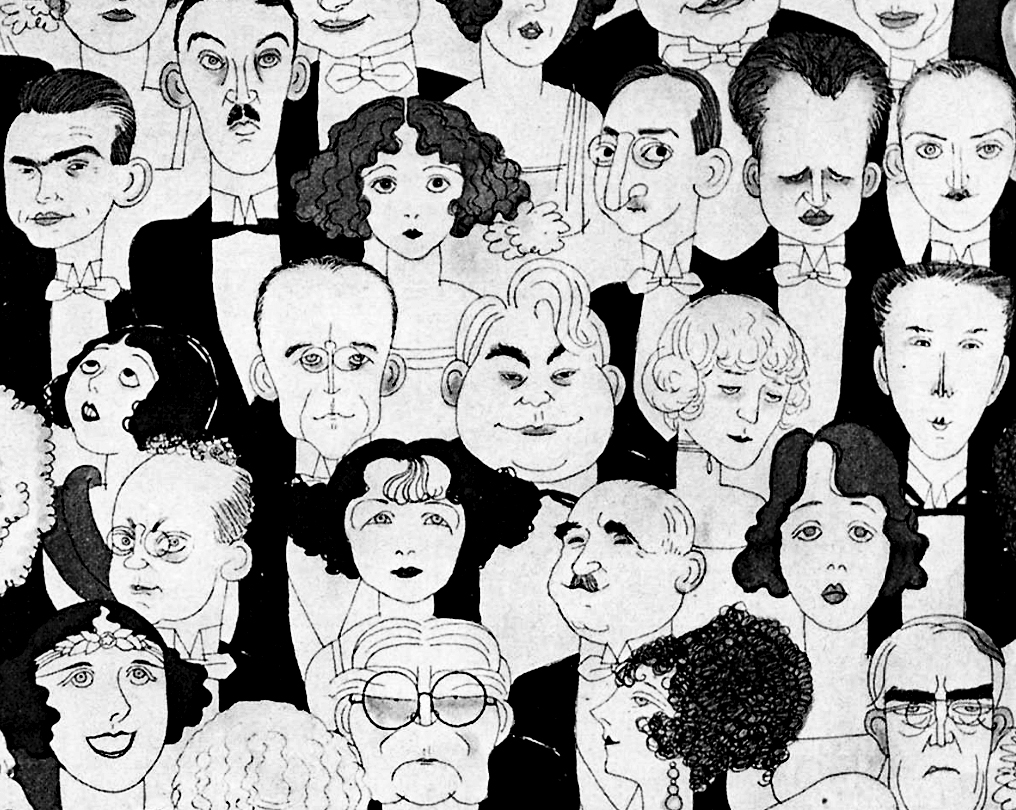 One of the most endearing portraits of Don Marquis was drawn by the brilliant 1920s book and magazine illustrator Ralph Barton. This image appeared in Liberty magazine on Sept. 26, 1925, one of two illustrations for Don’s light-hearted essay “The Curse of Efficiency.” (Scroll down the page for another view of Don by Ralph Barton, from the April 1922 edition of Vanity Fair magazine.)
One of the most endearing portraits of Don Marquis was drawn by the brilliant 1920s book and magazine illustrator Ralph Barton. This image appeared in Liberty magazine on Sept. 26, 1925, one of two illustrations for Don’s light-hearted essay “The Curse of Efficiency.” (Scroll down the page for another view of Don by Ralph Barton, from the April 1922 edition of Vanity Fair magazine.)
Category Archives: Literature
A Face In the Crowd
Don Marquis ranked in the top tier of Broadway celebrities in early 1922, even though his own comic masterpiece, “The Old Soak,” was still months away from its Broadway premiere (on Aug. 22, 1922). He is pictured here, fat and happy, surrounded by fellow first nighters in a classic Ralph Barton illustration that appeared in the April 1922 edition of Vanity Fair magazine titled “A Typical First Night Audience in New York:—The Scene Which Invariably Confronts the Actor.” Don is seated between Vanity Fair publisher Conde Nast and actress Elsie De Wolfe. In front of him are actress Irene Castle and arts patron Otto Kahn, with the tall, gangly Robert Sherwood in the row behind, to Don’s right. The old sourpuss in the lower-right corner is Don’s nemesis, the Rev. John Roach Straton, an angry fundamentalist minister who eagerly predicted the impending doom of heathen New Yorkers.
The complete, two-page illustration presents 91 spot-on caricatures. It is linked here, with its original key identifying all the celebrities of the day. Barton was famous for his group caricatures, and this one was a precursor to a similarly mammoth piece that appeared in the Jan. 4, 1923, issue of the old Life magazine (linked here) that once again shows Don in the thick of the action. (He’s on the left page, a bit off-center, with Robert Sherwood once again in the row behind, next to a bemused Robert Benchley!)
Something More?
We know Don Marquis today as a humorist (a satirist, really), but perhaps he should be remembered as something more—a humanist? The following lines are from an occasional column Don wrote in 1915 for Outlook magazine.
A LITTLE SYRIAN GIRL
I saw a little Syrian girl in a Brooklyn slum the other day who was sporting a pair of lavender-colored spats. Her stockings were somewhat out of repair; her toes were somewhat out of her shoes; the spats themselves had seen better feet; they had begun life as the spats of some one else, and they were too large for her. But they were spats—and she was happy.
She might have been happier if she could have danced. There was an organ-grinder on the block and other children were dancing. But when this particular little girl tried to dance the spats tripped her, So she gave it up and stood on the curbstone, spatted and superior, conscious Fashion queening it over Terpsichore. Her attitude conveyed that it was all very well for spatless children to dance in the streets, but that she had a certain position to maintain; she felt her social responsibility; if one has spats, one must live up to them. This was her outward attitude; this was the affectation forced upon her by the fact that with those particular spats she could not dance.
But all the while, deep in her ingenuous soul, there must have been stirring a conflict; she must have been debating whether she really wanted to miss the fun for the sake of the spats. In short, were spats worth while after all? Was dignity, eminence, worth the price?
Finally, nature won; affectation succumbed. She removed the spats and joined the dance. But it was too late. In a moment more the organ-grinder was gone. She resumed her spats; for a moment her face conveyed that she felt that she had lost both ways. But only for a moment. Presently the spats reasserted their sway; they communicated to their wearer a strut; she actually managed to strut standing still; to look at her now you would not have guessed that even a momentary doubt concerning spats had ever entered her mind; she became superior again.
I fancy the incident might be worked out on another plane and another scale in other streets. But what I enjoy about human beings is the fact that, no matter where one finds them, they are so human.
* * *

